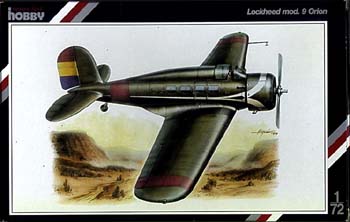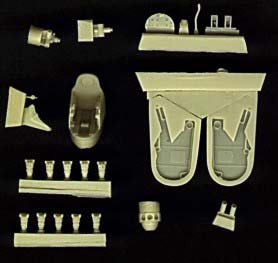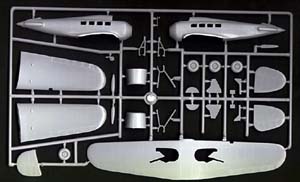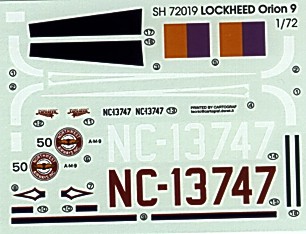


 Special
Hobby's 1:72 Lockheed Model 9 Orion
Special
Hobby's 1:72 Lockheed Model 9 Orion
By Chris Bucholtz
Introduction
The enterprising brothers Loughead (that's pronounced "Lockheed," by the way) sensed the market in mid-1930 for a light transport as air travel and transport began to gain importance. Unlike their competitors, Allan and Malcolm drew from their early designs instead of starting from scratch. They took the fuselage from their wildly successful (128 examples!) high-wing Vega and combined it with the low wing of their Model 8 Altair. The Altair had retractable landing gear, a feature first encouraged by Charles Lindbergh during the design of the Model 8 Sirius. The NACA cowling was added to further streamline the design.
The resulting aircraft was almost an archetypal 1930s design, with a streamlined fuselage, straight tapered wings and a decidedly art-deco look to it.
Only 35 Orions were built, but the planes had eventful careers. The first plane entered service with Bowen Air Lines in Houston in May, 1931, and the three dozen planes flew with 12 airlines. When the Spanish Civil War broke out, no fewer than 13 of these planes found their way into the hands of the Spanish Republican air force, starting in late 1936. One plane was impressed by the U.S. Army on the outbreak of the Second World War, becoming the UC-85. Another Orion was modified into the Orion-Explorer, which Wiley Post and Will Rogers used for their ultimately fatal attempted around-the-world flight.
 Special
Hobby's kit of the Model 9 is a beauty-40 short-run injection-molded parts,
a vacuformed canopy, and 23 resin pieces, plus a great decal sheet, and
optional parts to build the Model 9D. Everything is provided for save
the passenger cabin, an area that will be difficult to see once the fuselage
is closed up.
Special
Hobby's kit of the Model 9 is a beauty-40 short-run injection-molded parts,
a vacuformed canopy, and 23 resin pieces, plus a great decal sheet, and
optional parts to build the Model 9D. Everything is provided for save
the passenger cabin, an area that will be difficult to see once the fuselage
is closed up.
The pilot in the Orion sat under a fighter-style canopy away from his passengers. The kit provides for this area very well, with a cockpit tub, control panel, seat with seat belts, rudder pedals and a control column. The pedals need a little clean-up, but otherwise all are excellent. The engine is provided as a crankcase with nine separate cylinders (and a tenth, in case you lose one during assembly). The fin detail on the cylinders is good, although detail freaks will want to add pushrods and ignition wires.
Once the engine and cockpit are assembled, the modeler has to install the eight side windows. These are provided as injection-molded parts, and they're ..7mm oversize and need to be trimmed to fit the fuselage openings. Two of my eight had slight sinkmarks, but a little sanding and polishing should cure this.
 All
surface detail is recessed, with a few blemishes here and there that need
attention. Most in need of help are the canopy rails, which have irregularities
that must be knocked down. The horizontal and vertical tails are all provided
as separate pieces which butt-join the fuselage; care should be taken
in cleaning these parts up before joining them to the fuselage.
All
surface detail is recessed, with a few blemishes here and there that need
attention. Most in need of help are the canopy rails, which have irregularities
that must be knocked down. The horizontal and vertical tails are all provided
as separate pieces which butt-join the fuselage; care should be taken
in cleaning these parts up before joining them to the fuselage.
The wing is split into a single lower piece and upper wing halves. Inserts for the wheel wells are provided in resin, a nice touch, and the landing light is also provided as a resin piece. The cowling is split into halves, and resin exhaust pipes with recessed ends butt-join the cowling on each side. These might best be left off until after painting, or at least until the landing gear is in place. The kit provides bit a two-blade and a three-blade propeller, with two resin prop hubs and styrene blades that need a little attention to clean up. A plastic tail wheel and pitot, a resin venturi tube and pair of stretched sprue handles finish the exterior.
The landing gear is a complex affair. The wheels are provided as halves, and each gear has a support strut and a retracting arm. The Model 9 and Model 9D each had unique gear door arrangements, and again these are provided for, but the -9 has three doors per side while the -9D has four. The doors have a little interior detail, but it's somewhat rough; I'll sand mine clean and add detail from styrene strip. The canopy is beautifully clear and will allow all the cockpit detail to be visible even when the canopy is shut.
 The
decal options are outstanding, and depict two model 9Ds. The box-top subject
is a Spanish Republican Air Force machine, in U.S. light green over light
gray, with the red-yellow-purple flash on the tail and red bands on the
wings and fuselage. A stylized white stripe runs up the fuselage before
splitting to wrap around the cowling. The second is even more colorful-a
Northwest Airways 9D Special, finished in white with a brick-red stripe
on the upper wing. The Lockheed company logo goes on the tail, and a Northwest
Airways logo goes mid-fuselage. A red-and-black stylized arrow runs below
the passenger window to a point on the cowling. Giant civil registrations
appear atop the right wing in white and below the left wing in red. These
logos are absolutely spectacular. Whether you like warplanes or airliners,
you're well served by this kit.
The
decal options are outstanding, and depict two model 9Ds. The box-top subject
is a Spanish Republican Air Force machine, in U.S. light green over light
gray, with the red-yellow-purple flash on the tail and red bands on the
wings and fuselage. A stylized white stripe runs up the fuselage before
splitting to wrap around the cowling. The second is even more colorful-a
Northwest Airways 9D Special, finished in white with a brick-red stripe
on the upper wing. The Lockheed company logo goes on the tail, and a Northwest
Airways logo goes mid-fuselage. A red-and-black stylized arrow runs below
the passenger window to a point on the cowling. Giant civil registrations
appear atop the right wing in white and below the left wing in red. These
logos are absolutely spectacular. Whether you like warplanes or airliners,
you're well served by this kit.
Conclusion
A casual aficionado of '30s aviation, your reviewer is very excited by this lovely little kit. I can only imagine what real Golden-Age fans are experiencing at the sight of Special Hobby's Orion!

Previous: Contents







